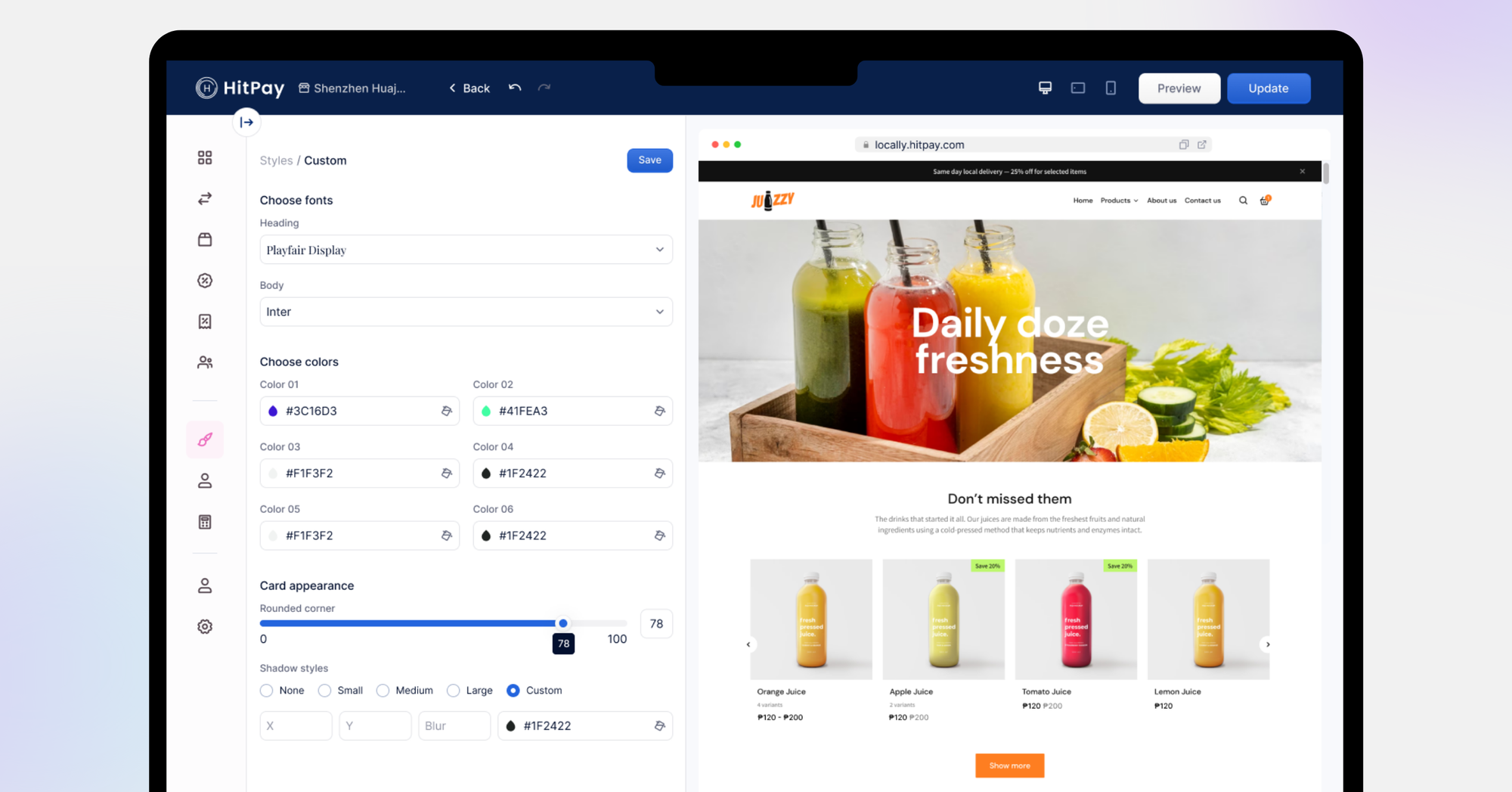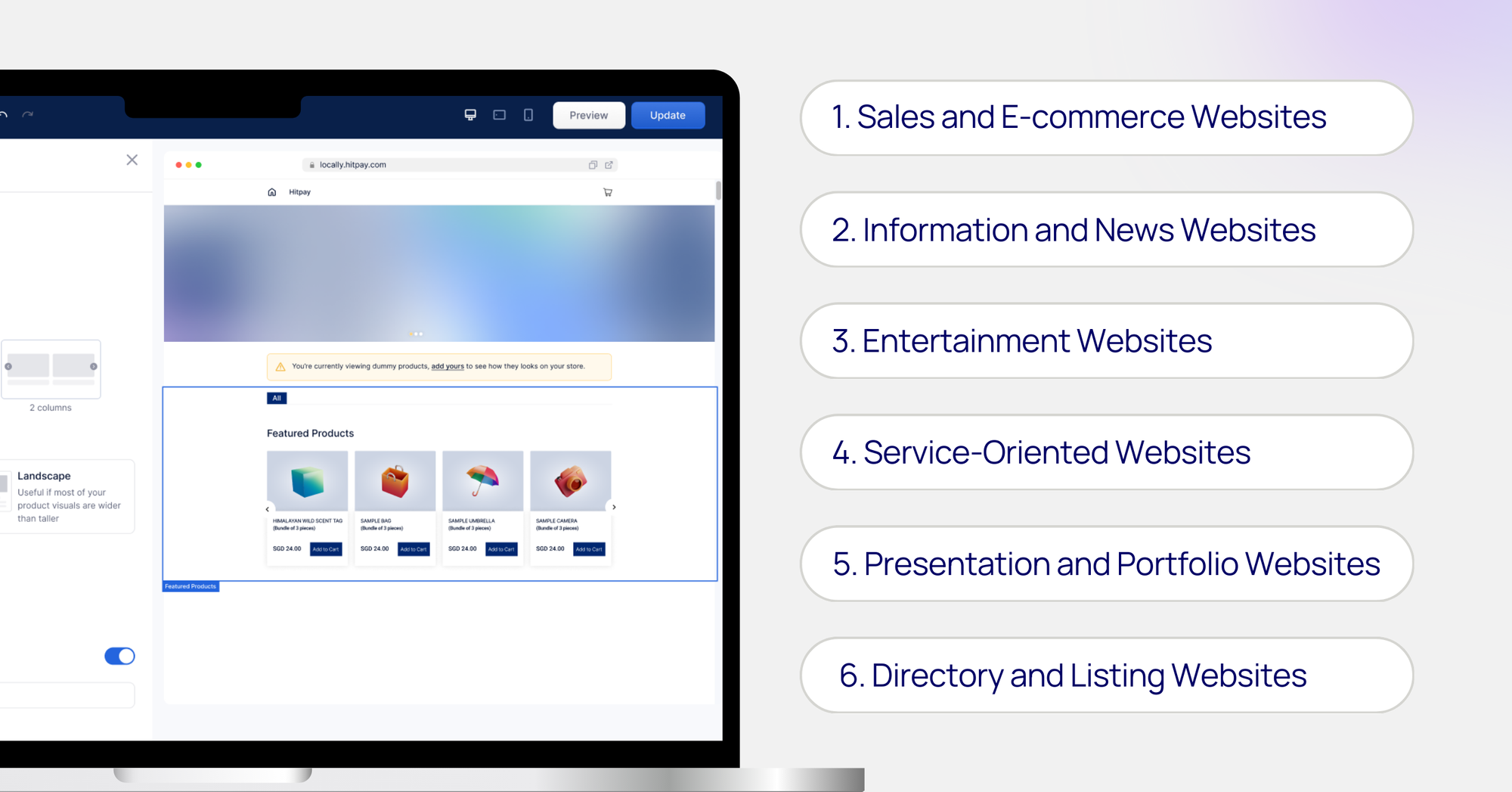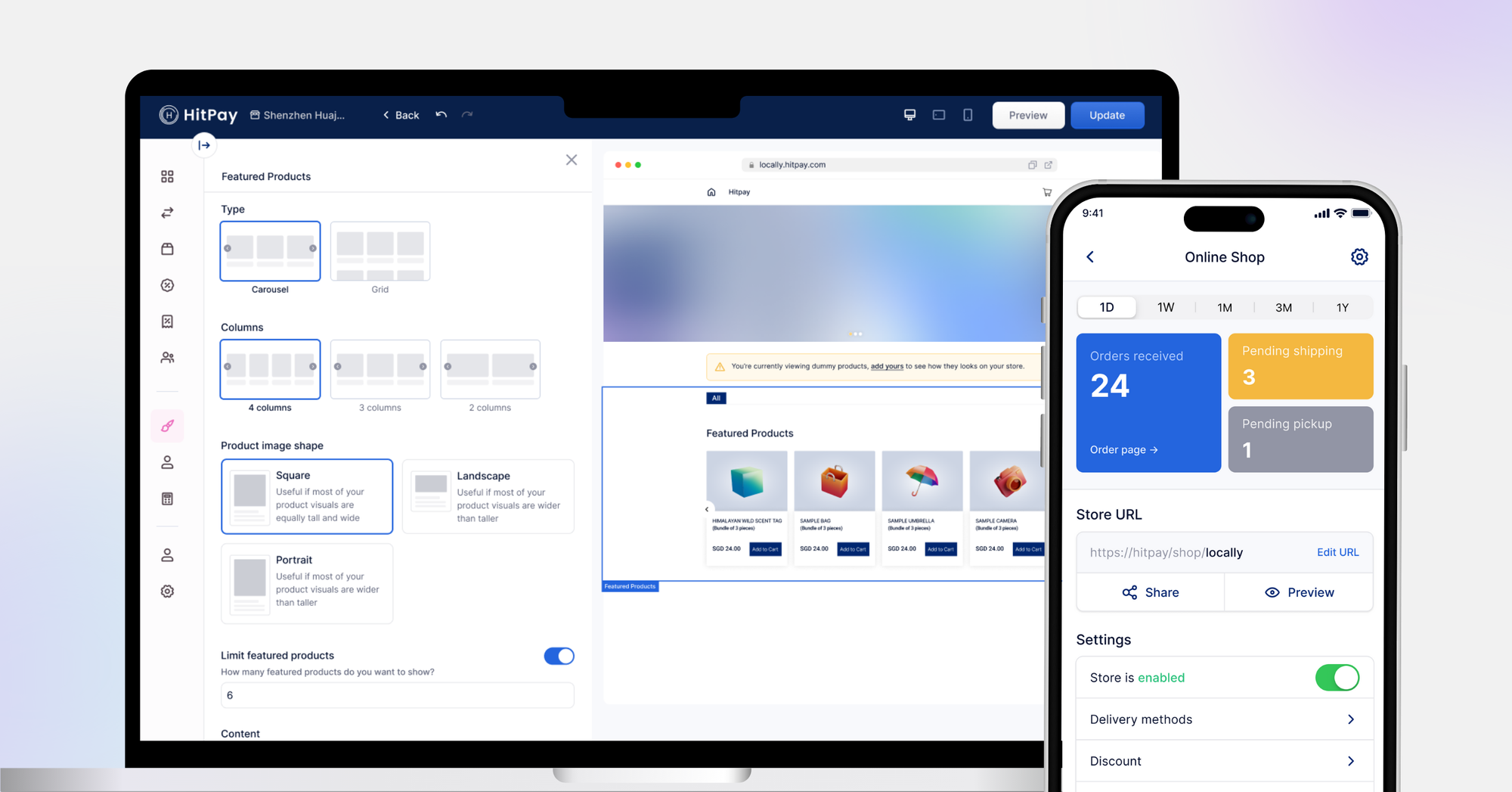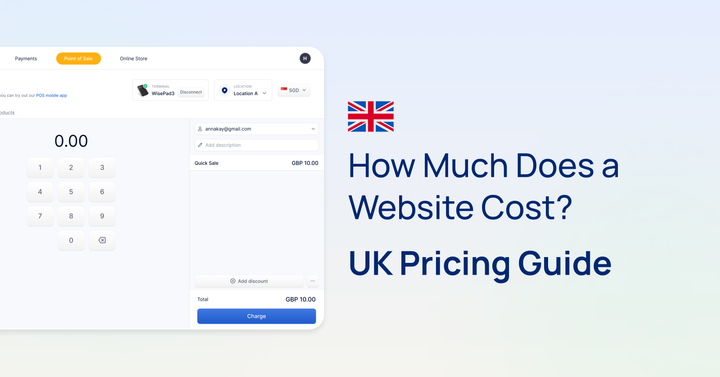The Core Objectives: Understanding the Purpose of Your Website
Learn how to define your website's purpose, from increasing brand awareness to driving sales or providing information, and discover strategies to design a site that aligns with your goals and meets audience needs effectively.


Creating a business website is more than just putting content online—it's about building a valuable tool that serves a specific purpose for your business. Whether your goal is to increase brand awareness, drive sales, or provide valuable information, a well-designed website is key.
But building a great website doesn’t stop at design and content. Integrating effective payment solutions, like those offered by HitPay, ensures that your website is also equipped to handle transactions smoothly and securely. HitPay helps thousands of businesses simplify their payments, making it an ideal partner for your online growth.
In this article, we’ll explore the different purposes a website can serve, from increasing brand awareness to driving sales or providing valuable information. We'll help you identify the primary purpose of your website and offer practical tips on how to design and build a site that aligns with your goals.
Key Takeaways:
- Establish your website's primary purpose before beginning design and content creation.
- Website owners objectives can vary, including increasing awareness, driving sales, or sharing information.
- Clearly defined website goals enhance the user experience and site effectiveness.
- Understanding your target audience is crucial to defining your website's purpose.
What is the Purpose of a Website?

The purpose of a website goes beyond just having an online presence; it serves specific objectives that help fulfil business or personal goals. While each website has unique aims, these goals generally fall into three main categories:
- Generating Awareness: This type of website focuses on increasing visibility and promoting a brand, product, or cause.
- Driving Sales: Ecommerce websites are designed to facilitate transactions and convert visitors into customers.
- Delivering Information: Informational websites aim to educate or inform their audience by providing valuable content.
Understanding these core purposes allows you to strategically design and structure your website for optimal performance. There are many things to consider when building a website, and each decision can significantly impact user experience, search engine optimization (SEO), and conversion rates.
Defining the Main Goals
The main goals of your website are the foundation upon which its design, structure, and content are built. Here are key points to consider:
- Generating Awareness: For websites focused on visibility, content marketing, SEO, and social media integration are critical. In 2023, there were around five billion social media users worldwide, making platforms like Facebook, Instagram, and LinkedIn essential for reaching and engaging with potential audiences. These strategies help attract potential customers, industry influencers, and media attention.
- Driving Sales: E-commerce sites prioritise user-friendly interfaces with clear calls to action and a seamless checkout process to turn visitors into buyers.
- Delivering Information: Websites that focus on providing information use content like articles, tutorials, and news to engage visitors who are looking for knowledge or solutions.
By setting clear goals for your website, you can create targeted strategies that effectively meet your audience's needs and achieve your objectives.
6 Different Types of Website Purposes

Websites serve various functions, each designed to achieve specific outcomes. Understanding the different types of website purposes helps you choose the right one for your online presence and select the best website builder to achieve your goals effectively.
- Sales and E-commerce Websites
Sales and e-commerce websites are specifically designed to sell products and services directly to customers, making them essential players in the rapidly growing online marketplace.
The global e-commerce market is expected to total $6.3 trillion in 2024, highlighting the immense opportunity for businesses to reach a vast and diverse audience. These sites prioritise a seamless shopping experience, with features like easy navigation, clear product descriptions, and secure payment gateways.
They often incorporate user reviews, product recommendations, and personalised suggestions to build trust and encourage purchases. Additionally, these websites use marketing tools such as email campaigns, discount codes, and retargeting ads to boost sales and customer retention.
- Information and News Websites
Information and news websites aim to inform, educate, or provide up-to-date news to their visitors. These sites focus on delivering high-quality, authoritative content, including articles, tutorials, research studies, and news updates.
They often cover a wide range of topics, catering to diverse audience interests. To maintain engagement and trust, these websites typically employ strategies such as frequent content updates, multimedia elements (videos, infographics), and user interaction features (comments, polls).
- Entertainment Websites
Entertainment websites are designed to engage visitors by offering multimedia content like videos, music, games, podcasts, and interactive experiences.
These sites aim to capture users' attention and keep them engaged for longer periods, often relying on high-quality visuals, engaging storytelling, and interactive features. They may generate revenue through ads, subscriptions, or partnerships.
For instance, platforms like Netflix and Spotify leverage algorithms to tailor content recommendations, which significantly boosts user satisfaction and retention. In fact, Netflix has revealed that approximately 80 percent of the shows watched by its users are discovered through these personalised suggestions, demonstrating the powerful impact of algorithm-driven engagement on viewer habits and platform loyalty.
- Service-Oriented Websites
Service-oriented websites are built to showcase a company’s services, such as consulting, legal aid, healthcare, or repair services. They aim to establish credibility, communicate value, and encourage potential clients to make contact or request a quote.
These sites often feature service descriptions, client testimonials, case studies, and easy-to-use contact forms. They may also offer booking or scheduling tools to facilitate direct engagement.
- Presentation and Portfolio Websites
Presentation and portfolio websites are used by creative professionals, such as photographers, artists, designers, writers, and developers, to showcase their work.
These sites serve as an online portfolio, allowing users to display their skills, style, and past projects in a visually appealing manner. The design is typically clean and minimalistic to highlight the work itself, often including high-resolution images, videos, and detailed project descriptions.
- Directory and Listing Websites
Directory and listing websites compile lists of businesses, services, or products, providing users with a comprehensive database of options to choose from.
These sites are designed to facilitate decision-making by offering detailed information, ratings, reviews, and sometimes comparisons. They serve as a bridge between users and businesses, helping consumers find what they need quickly and efficiently.
Studies show that 93% of consumers say online reviews impact their purchasing choices, highlighting the importance of incorporating authentic feedback to attract and retain customers. Popular examples like Yelp and TripAdvisor provide user-generated content and reviews to enhance credibility and trust, which is crucial for influencing consumer decisions.
How to Identify Your Website's Purpose

Identifying your website's purpose starts with understanding your target audience. Knowing who your visitors are and what they seek helps you create a website that meets their needs and expectations. Here’s how to determine your website’s purpose effectively:
Understanding Your Target Audience
Your website should be tailored to the needs and preferences of your target audience. To do this, consider the following factors:
- Demographics: Age, gender, location, education level, and income can influence what content and design elements resonate best.
- Interests: Knowing your audience's hobbies, preferences, and online behaviours helps create engaging content.
- Challenges: Understand the problems your audience faces that your website can help solve. This knowledge allows you to provide valuable solutions.
By understanding your audience, you can create a user-friendly website that engages visitors and encourages them to take desired actions.
Aligning with Business Goals
Once you understand your audience, align this knowledge with your broader business objectives. Set clear goals for your website, such as:
Defining these goals helps focus your efforts and ensures your website meets both your audience's needs and your business objectives, turning it into a powerful tool for success.
Benefits of Clearly Defined Website Objectives
Having well-defined objectives brings numerous advantages, enhancing the overall performance and effectiveness of your website. Think about the purpose of the website and what makes your business stand out from others.
Improved User Experience
Clearly defined website objectives result in a more focused design and structure, making it easier for visitors to navigate and find the information or products they seek. This leads to a smoother and more intuitive user journey, minimising frustration and reducing bounce rates.
When visitors can quickly locate what they need, their overall satisfaction with the site increases, which encourages them to spend more time exploring content or services.
Enhanced SEO Performance
When your website objectives are clearly defined, it becomes easier to align your content with SEO best practices, such as using targeted keywords, optimising meta descriptions, and implementing proper header tags.
A focused objective allows for the strategic development of content that meets the specific needs of your audience, improving relevance and engagement.
Search engines, like Google, reward websites that provide valuable, well-structured content by ranking them higher in search results. Improved SEO performance means greater visibility, driving more organic traffic to your website.
Better Conversion Rates
When your website’s design and content are aligned with its goals, visitors are more likely to complete desired actions, whether that’s making a purchase, signing up for a newsletter, or filling out a contact form. When every element of your site— from calls to action (CTAs) to content placement— is aligned with your goals, it creates a cohesive path that directs users toward conversion points.
Common Pitfalls in Website Purpose Definition and How to Avoid Them
Defining your website’s goals is crucial, but it’s easy to make mistakes that can undermine your efforts. Here are common pitfalls and how to avoid them ruining your website:
Lack of Clear Objectives
A website without clearly defined objectives often ends up being disorganised and ineffective. Without specific, measurable goals, it can be challenging to determine what content to include, how to design the site, or what calls to action (CTAs) to use.
This lack of direction can result in a confusing user experience, lower engagement, and missed opportunities for conversions. To avoid this pitfall, start by identifying your primary goals, such as increasing brand awareness, generating leads, or driving e-commerce sales
Ignoring User Needs
Even with a clear set of objectives, a website can fail if it doesn't consider the needs and preferences of its target audience. A common mistake is assuming what visitors want rather than conducting proper research.
This can lead to content, features, or design elements that do not resonate with your users, resulting in high bounce rates and low engagement.
To avoid this, conduct thorough user research, such as surveys, focus groups, and usability testing, to gather insights into your audience’s behaviours, preferences, and pain points. 78% of businesses that conduct user research exceed their revenue goals, demonstrating the significant impact of understanding and addressing user needs on overall business success.
Overcomplicating the Design
A complicated website design can overwhelm visitors, making it difficult for them to navigate or find the information they need. Overuse of visual elements, excessive menus, or too many interactive features can lead to cognitive overload, causing frustration and driving users away.
To avoid this, focus on simplicity and clarity in your design. Use a clean layout with intuitive navigation, consistent branding, and a clear hierarchy of information. Ensure that every design element has a purpose and contributes to the overall goal of the site.
Get Started With HitPay’s Secure Website Builder

Understanding the purpose of your website is essential for its success. By defining clear goals that align with your audience's needs and your business objectives, you can create a targeted digital strategy that attracts and engages visitors.
Avoid vague objectives, neglecting user needs, and overly complex designs to maintain focus and usability. A well-defined purpose not only shapes your website's design but also drives its performance, contributing to your online success.
Try HitPay’s Online Website Builder for free today.
If you're a customer who has questions about paying with HitPay, feel free to contact us on our website.
FAQs
What are the main purposes of a website?
Websites have multiple purposes and are created to increase awareness, drive sales, or provide information. The specific focus will depend on the website's target audience and business information and objectives.
How can I identify my website's purpose?
Start by researching your audience's demographics, interests, and challenges. Then, align these insights with your business goals to create a clear strategy for your website.
What are the benefits of clearly defined website objectives?
Clear website goals improve user experience, enhance SEO performance, and increase conversion rates by providing focused content and a user-friendly design.
What are the common pitfalls in defining a website's purpose and different goals?
Common mistakes include having vague objectives, ignoring user needs, and overcomplicating the design. Avoid these by setting clear goals, understanding your audience, and keeping your design simple.
How do e-commerce company websites differ from information websites?
E-commerce websites focus on selling products or services through online tools, while information websites provide content to educate or inform visitors on specific topics.


